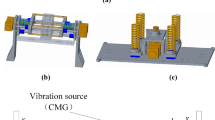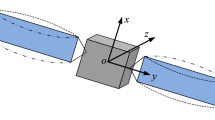Abstract
Background
A lot of efforts have been devoted to the instrument development of simultaneous precision positioning and vibration control for on-orbit optical payloads. However, only series schemes with two active elements which, in fact, are coarse and fine hybrid mechanisms, are researched in despite of adverse impacts on the whole mass and dimensions, control strategy and energy usage. Thus, a new magnetostrictive integrated actuator with just one single active element is proposed to realize those two functions together.
Methods
The detailed scheme is introduced, and the selection of some key parameters are explained first. Then, the explicit expressions are derived and the performances are preliminarily studied by numerical simulations. Finally, a prototype is fabricated, and experimental tests are carried out in view of external disturbances with different frequencies.
Conclusions
The results indicate that the developed actuator can not only actively control the low-frequency disturbances but also can passively suppress the middle-high frequency micro-vibrations during precision positioning.
























Similar content being viewed by others
References
Li M, Zhang Y, Wang YY et al (2019) The pointing and vibration isolation integrated control method for optical payload. J Sound Vib 438:441–456
Syam WP, Wu JW, Bo Z et al (2018) Design and analysis of strut-based lattice structures for vibration isolation. Precis Eng 52:494–506
Pyeon BD, Kim JH, Bae JS (2020) A study on frequency characteristics of structural hinge stiffness. J Vib Eng Technol. https://doi.org/10.1007/s42417-020-00222-5
Ciani G, Arain MA, Aston SM et al (2016) Small optic suspensions for advanced LIGO input optics and other precision optical experiments. Rev Sci Instrum 87:114504
Wang Y, Jing XJ, Dai HH et al (2019) Subharmonics and ultra-subharmonics of a bio-inspired nonlinear isolation system. Int J Mech Sci 152:167–184
Eisenhower MJ, Cohen LM, Feinberg LD et al (2015) ATLAST ULE Mirror segment performance analytical predictions based on thermally induced distortions. Proc SPIE 9602:9601–9618
Ma KG, Ghasemi-Nejhad MN (2005) Adaptive simultaneous precision positioning and vibration control of intelligent composite structures. J Intell Mater Syst Struct 16:163–174
Ma KG, Ghasemi-Nejhad MN (2007) Adaptive input shaping and control for simultaneous precision positioning and vibration suppression of smart composite plates. Smart Mater Struct 16:1870–1879
Hara S, Yoshida K (1996) Simultaneous optimization of positioning and vibration control using a time-varying frequency-shaped criterion function. Control Eng Pract 4:553–561
Kang MS (2013) Simultaneous positioning and vibration control of chip mounter with structural flexibility. J Semicond Disp Technol 12:53–59
Eshraqi E, Shahravi M, Azimi M (2016) Vibration suppression and precision positioning of a piezoelectric beam with graded properties. Int J Eng Appl Sci 8:16–25
Hu QL (2008) Input shaping and variable structure control for simultaneous precision positioning and vibration reduction of flexible spacecraft with saturation compensation. J Sound Vib 318:18–35
Ghasemi-Nejhad MN, Ma KG (2010) Simultaneous thrust vector control and vibration isolation of satellites using steerable smart platforms. Proc SPIE 7643:76431–76438
Juhasz L, Mass J (2013) Control of hybrid nanopositioning systems for trajectory-tracking applications. Mechatronics 23:617–629
Chan KW, Liao W (2006) Precision positioning of hard disk drives using piezoelectric actuators with passive damping. In: 2006 International conference on mechatronics and automation, Luoyang, pp 1269–1274
Rakotondrabe M, Ivan IA (2010) Development and dynamic modeling of a new hybrid thermopiezoelectric microactuator. IEEE Trans Robot 26:1077–1085
Yun H, Liu L, Li Q et al (2020) Investigation on two-stage vibration suppression and precision pointing for space optical payloads. Aerosp Sci Technol 96:105543
Ortiz GG, Farr WH, Charles J et al (2009) Canonical deep space optical communications transceiver. Proc SPIE 7199:71990
Sannibale V, Ortiz GG, Farr WH (2019) A sub-Hertz vibration isolation platform for a deep space optical communication transceiver. Proc SPIE 21:7199
Thayer D, Campbell M, Vagners J (2002) Six-axis vibration isolation system using soft actuators and multiple sensors. J Spacecr Rockets 39:206–212
Wang CX, Xie XL, Chen YG et al (2016) Investigation on active vibration isolation of a Stewart platform with piezoelectric actuators. J Sound Vib 383:1–19
Sun XQ, Yang BT, Zhao L, Sun XF (2016) Optimal design and experimental analyses of a new micro-vibration control payload-platform. J Sound Vib 374:43–60
Huang XC, Su ZW, Wang S et al (2020) High-frequency disturbance force suppression mechanism of a flywheel equipped with a flexible dynamic vibration absorber. J Vib Control 1–12
Ito S, Schitter G (2016) Comparison and classification of high-precision actuators based on stiffness influencing vibration isolation. IEEE ASME Trans Mechatron 21(2):1169–1178
Sun XQ, Liu YC, Hu W et al (2020) Design optimization of a giant magnetostrictive driving system for large stroke application considering vibration suppression in working process. Mech Syst Signal Process 138:106560
Niu MQ, Yang BT, Yang YK et al (2018) Two generalized models for planar compliant mechanisms based on tree structure method. Precis Eng 51:137–144
Chen GM, Han Q, Jin KF (2020) A fully compliant tristable mechanism employing both tensural and compresural segments. J Mech Robot 12:011003
Sun XQ, Yang BT (2017) A new methodology for developing flexure-hinged displacement amplifiers with micro-vibration suppression for a giant magnetostrictive micro drive system. Sens Actuators A 263:30–43
Tao WQ (2006) Heat transfer. Beijing University of Aeronautics and Astronautics Press, Beijing
Lu QG, Chen DF, Zhong YN et al (2007) Research on thermal deformation and temperature control of giant magnetostrictive actuator. Chin Mech Eng 18:16–19
Chen GM, Wang JL, Liu XY (2014) Generalized equations for estimating stress concentration factors of various notch flexure hinges. J Mech Des 136:031009
Jiles DC, Atherton DL (1983) Ferromagnetic hysteresis. IEEE Trans Magn 19:2183–2185
Zheng XJ, Liu XE (2005) A nonlinear constitutive model for Terfenol-D rods. J Appl Phys 97:053901
Yang Y, Yang B, Niu M (2018) Adaptive trajectory tracking of magnetostrictive actuator based on preliminary hysteresis compensation and further adaptive filter controller [J]. Nonlinear Dyn 92(3):1109–1118
Balaji PS, Selvakumar K (2020) Applications of nonlinearity in passive vibration control: a review. J Vib Eng Technol. https://doi.org/10.1007/s42417-020-00216-3
Acknowledgements
The authors would like to thank the useful comments and constructive suggestions from the handing editor and anonymous reviewers. This research was supported by National Natural Science Foundation of China (no. 51905087), the Fundamental Research Funds for the Central Universities (no. 2232019D3-37) and the Initial Research Funds for Young Teachers of Donghua University (no. 103-07-0053049).
Author information
Authors and Affiliations
Corresponding author
Ethics declarations
Conflict of interest
On behalf of all authors, the corresponding author states that there is no conflict of interest.
Additional information
Publisher's Note
Springer Nature remains neutral with regard to jurisdictional claims in published maps and institutional affiliations.
Rights and permissions
About this article
Cite this article
Sun, X., Yang, B., Hu, W. et al. Simultaneous Precision Positioning and Vibration Control for on-Orbit Optical Payloads: An Integrated Actuator Development and Analysis. J. Vib. Eng. Technol. 9, 507–528 (2021). https://doi.org/10.1007/s42417-020-00244-z
Received:
Revised:
Accepted:
Published:
Issue Date:
DOI: https://doi.org/10.1007/s42417-020-00244-z




